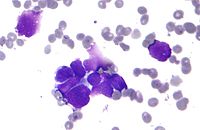
Photo from wikipedia
To clarify imaging and clinical characteristics of ovarian carcinosarcoma (CS) compared with high-grade serous carcinoma (HGSC). We retrospectively reviewed MR imagings of 12 patients with CS and 30 patients with… Click to show full abstract
To clarify imaging and clinical characteristics of ovarian carcinosarcoma (CS) compared with high-grade serous carcinoma (HGSC). We retrospectively reviewed MR imagings of 12 patients with CS and 30 patients with HGSC and evaluated tumor size, shape, appearance, nature of cystic and solid components, hemorrhage, and necrosis. Age, premenopausal or postmenopausal, histologic subtype, presence of endometriosis, tumor markers, and stage were also evaluated. These parameters were compared using the Mann–Whitney U test and the chi-square test/Fisher’s exact test. The mean size of CSs was 13.6 cm, and significantly larger than that of HGSCs (mean 9.0 cm, p = 0.022). The stained-glass appearance (67% vs. 23%, p = 0.013), hemorrhage (100% vs. 50%, p = 0.003), necrosis (75.0% vs. 13%, p = 0.000), and endometriosis (33% vs. 7%, p = 0.012) were significantly more common in CSs. The postmenopausal ratio of CSs was 100% and significantly higher than that of HGSCs (70.0%, p = 0.041). Among the tumor makers, only CA-125 was significantly lower in CSs than in HGSCs (mean 715.1 U/ml vs. 1677.1 U/ml, p = 0.009). The stage distribution was similar and was not significantly different. CSs formed larger masses, and the stained-glass appearance, hemorrhage, and necrosis were more frequently observed in CSs.
Journal Title: Japanese Journal of Radiology
Year Published: 2020
Link to full text (if available)
Share on Social Media: Sign Up to like & get
recommendations!